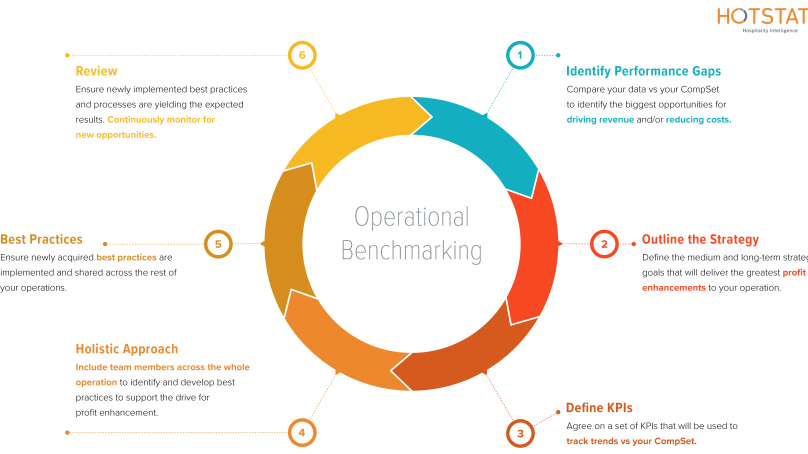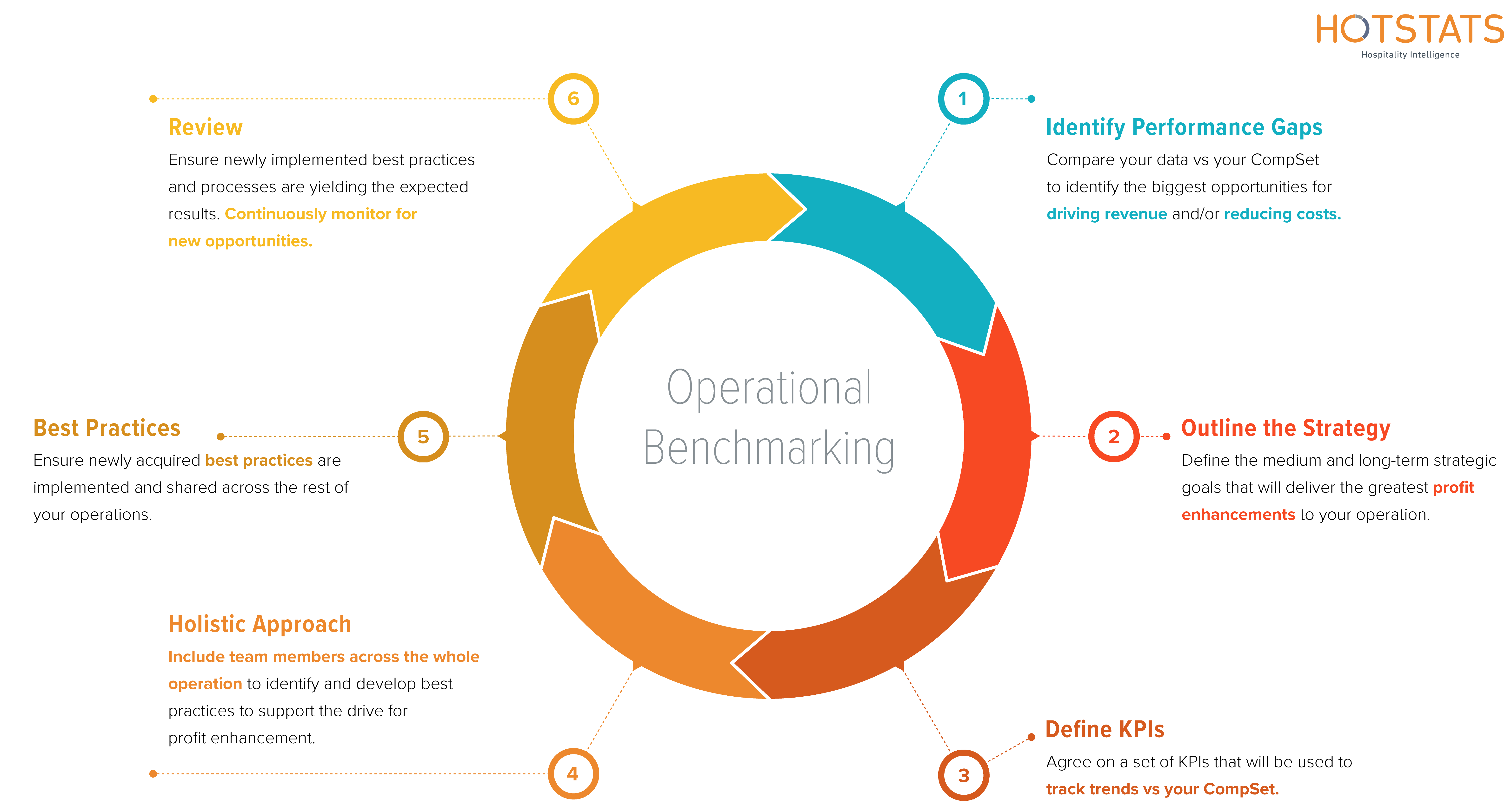Going beyond RevPAR and analyzing hotel profitability isn’t only smart, it’s imperative. HotStats discusses why you should—and can!—benchmark profitability
Hotels are complex operations—and optimizing their profitability is all about finding the right mix of revenue growth and expense control to provide the greatest flow through to the bottom line. Typically, for full-service hotels, rooms revenue accounts for approximately 65 percent of the total revenue. That leaves an additional 35 percent of revenue earned elsewhere, in areas such as food & beverage, golf, spa, parking or other operated departments. Ignoring those areas is tantamount to leaving money on the table.
Put simply: Revenue alone is not a barometer of success; generating positive cash flow and profitability is equally—if not more—important. Sure, revenue is an essential piece of the profitability puzzle, but if a hotel operator doesn’t effectively manage expenses, profits are bound to dry up with every increase in costs. Therefore, all facets of the operation should be examined on a regular basis. This analysis can be conducted internally or by benchmarking externally to the competition.
Operational Benchmarking in the Hospitality Industry
A hotel is a living, breathing, 24/7 operation that continually needs direction and supervision. Unlike other asset classes that have fixed leases and less operational variables, hotels are constantly in flux. Turnover is frequent and inventory is perishable: an unoccupied room is lost revenue that can never be recouped.
Meanwhile, as hotels have evolved and matured, other departments beyond rooms have grown up. That is why hoteliers need to think about the structure as a whole, and not unconnected parts: each area has a consequential impact on the bottom line.
Consider not only the revenue-generating part of the operation such as rooms, food & beverage or spa, but also the administrative department, information technology, sales and marketing and property and maintenance. How do each of these areas impact profitability? And are processes in place to optimize profitability? If so, how is the effectiveness of these processes being measured? Guess work is not enough to put a hotel ahead; hotels need reliable, in-depth and objective assessment. Operational benchmarking is that guiding post.
The renowned American engineer and statistician W. Edwards Deming said it best: “Without data, you’re just another person with an opinion.”
What Is Benchmarking & How Does It Work?
In a nutshell, operational benchmarking is the cyclical process of putting measurement into action. More specifically, it is the monthly evaluation of every department within a property against its competitors, with the objective of finding and developing best practices to streamline operations and generate higher profits.
There are six steps toward understanding how benchmarking leads to profit optimization:
- Step #1: Identify Performance Gaps
- Step #2: Outline the Strategy
- Step #3: Define KPIs
- Step #4: Holistic Approach
- Step #5: Best Practice
- Step #6: Review
Step #1: Identify Performance Gaps
Knowing where you are is the first step toward knowing where you need to go and how to arrive there. Just like a GPS needs to first locate a vehicle on the map before calculating the best route to its destination, every company needs to understand where it is situated within the competitive landscape in order to define a successful strategy for the future.
Think of operational benchmarking, then, as your GPS. How can you identify your current location? The first step is comparing your data and departmental KPIs to those of your competitors. Many questions will arise during this exploratory analysis, such as: “How are our competitors achieving a higher average room rate?” or “Why is our cost of food higher than our competitors?” These questions will help you identify performance gaps, singling out opportunities for enhancing revenues and reducing costs. Thus, as per our GPS analogy, you will know your exact location on the competitive map; furthermore, the different routes which will lead you to your ultimate goal: profit optimization.
Step #2: Outline the Strategy
Now that you have established the starting point, it is time to define where you want to go. Based on the performance gaps you identified, you should assess which objectives will be conducive toward increasing profits in your operation. This second step is the outline of your strategy, which involves defining medium- and long-term goals. Per our GPS analogy, the long-term goal is the final destination. For a hotel, the desired outcome is to convert revenues into profits, thus maximizing the bottom line.
In order to achieve this desired state, there are immediate steps that need to be taken, including examining labor costs (the largest hotel expense ), lowering F&B cost of sales or investigating total overhead expenses to drive increases to the bottom line.
It is also important to prioritize objectives so that an action plan can be designed and resources allocated accordingly. At this stage, you need to consider how your strategy will impact the processes, systems and people in the organization. What are the company’s strengths and weaknesses? What competencies are to be developed in order to achieve the set goals? And, are your goals realistic? Once the strategy has been outlined, the next step is to decide how you are going to measure its success.
Step #3: Define Key Performance Indicators
Now that you know where you are and where you want to go, how can you tell if you are moving in the right direction? Your GPS has multiple ways of showing the answer, such as displaying the miles left to reach your destination or the time remaining until arrival. The key here is to ensure you have a quantitative way of measuring progress; the same principle applies to operational benchmarking objectives. Without measurement, there is no reliable way to judge whether you are moving closer to accomplishing your objectives or if you have gone off track. These measures are often referred to as key performance indicators (KPIs).
Your choice of KPIs should reflect the objectives you want to pursue. For example, if you are focused on assessing F&B operations, look at measurements such as F&B revenue per customer, F&B cost of sales as a percentage of F&B revenues or F&B profit as a percentage of F&B revenue. Once selected, this set needs to be measured regularly, ideally on a monthly basis, then used to make intra-hotel decisions and to identify critical trends that could impact the hotel down the line .
KPIs also need targets. Just as the terms “near” and “far” are meaningless unless a destination is made explicit, measuring KPIs without a performance target is futile. How much spa revenue should drop to the bottom line? Has the target been achieved? Why, or why not? If not, what decisions can be made to get back on track? These kinds of questions are crucial toward the evaluation of any strategy and can only be answered with explicit targets and reliable measures.
Step #4: Holistic Approach
No man is an island—especially when it comes to deploying a business strategy. In order to successfully achieve desired long-term goals, it is essential to have every team member fully committed. The company’s strategy needs to be clearly communicated to assure that everyone understands their purpose and role. In particular, measuring KPIs across the organization will facilitate the identification and development of best practices to effectively meet the desired targets and, consequently, generate more profits in the end.
Just as your GPS integrates data from myriad sources to configure the best route (average speed, traffic, accidents, etc.), you will need to include inputs from across the organization to create effective processes to reach your goal. Are there any wasteful redundancies in your procedures? What are the critical bottlenecks and how can you bypass them? Are these common problems within the market? What are your competitors doing?
Operational benchmarking is the framework that allows for critical procedural assessment with the purpose of optimizing results at each step.
Step #5: Best Practices
By the time you reach this step in the operational benchmarking process, you are ready to act and put best practices into place. You have determined what needs to be done to reach optimal levels and set your operation on the right course. At this point, communication plays a critical role. Your GPS would be quite useless if, after taking in all the data, it didn’t display the route. So, too, is the case with best practices. To ensure full and correct implementation, action items should be shared with team members to assure that everybody understands any changes to be made or new processes to implement.
Old habits are hard to break and can sneak back in if the significance of change is not conveyed properly. In order to stave off recidivism, take the time and explain to team members why these new processes are important and how they will provide a positive impact on the operation. It is also crucial to routinely verify that best practices are executed in a uniform manner across the entire operation. Remember: Rigorous implementation is the only pathway to achieve the positive outcomes you are looking to achieve.
Step #6: Review
Once best practices are shared and implemented across the organization, it is time to take a step back and analyze whether these procedures are yielding the expected results. After measuring the relevant KPIs for your organization, ask yourself: Are we where we want to be? Are we meeting targets? Do we need to modify our strategy? It could be that during the process certain relevant variables in the market changed and you need to adjust and make accommodations. For example, maybe you set goals for rooms profit, but new supply has entered the market causing rate and occupancy to trend down. How can you adjust to this change in market supply and demand?
If you have achieved all that you set out to do, take a moment to celebrate, but do not become complacent. Continual improvement and monitoring are parts of the unceasing optimization process.
The Compelling Case for Benchmarking
After outlining the steps of benchmarking, the question remains: Why is operational benchmarking necessary? Benchmarking allows for identification of industry best practices. By assessing your organization’s KPIs against current market trends, you can identify your most pressing operational issues and the best way to solve them—all at once!
Hotel operations are, however, very complex; how, then, can we make measure against our competitors—compare apples to apples? In the lodging industry, operational accounting standards are outlined in the Uniform System of Accounts for the Lodging Industry (USALI). The current 11th edition of the USALI provides guidance on the recording of revenue, cost of sales, labor costs and expenses for the various hotel departments. By using these set standards, organizations are one step closer toward realizing their operational benchmarking goals. Another step to confirming comparability is partnering with the right benchmarking organization, which will ensure that all the data is matched and comparable.
Furthermore, benchmarking compels your organization to be in a constant process of improvement, allowing you to be more responsive and better prepared in the face of changing market conditions. Above all, benchmarking changes the mindset and culture of an organization, making it more dynamic, creative and receptive to new opportunities that can lead to profit maximization.
HotStats
Add to Favorites 















